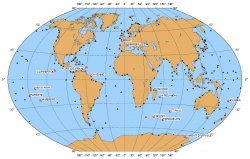
Origin of SONEL
Origin of SONEL
SONEL was born out of the difficulty that the international programs had encountered in obtaining observations from French coastal tide gauges. These difficulties were related to the diversity of the devices that were used as well as their primary use, the organizations in charge of running them, their status and their purpose. The scientific aim of the international programs is to observe and understand the changes in the different components of sea-level. On the world scale this task is accomplished by the GLOSS programme of the International Oceanographic Commission (IOC) of UNESCO, launched in 1985, to which the French initially proposed to contribute fifteen tide gauges (click on the map).
Until 2010, unfortunately it was undeniable that few of the French sites met the criteria of the GLOSS program (IOC 2006, pp.52). The philosophy behind the development of this program was one of “best effort” and voluntary participation, but this has its limitations. One of the principle limitations is the level of financing received by the organizations which run the stations. Funding is in principal commensurate with the operational missions that are inscribed in their statutes but these missions are often less demanding in terms of metrology than the study of climate-induced changes in sea level or the ‘in situ’ monitoring of satellite radar altimeters .
However, in 2002, these organizations did understand that the importance of the heritage that they manage sometimes extends beyond their missions (observation sites which are sometimes one hundred years old or more), which is the case for example in Brest (SHOM) and Marseilles (IGN). Efforts were made but these were still far removed from the main preoccupations of researchers, and their responsiveness in maintaining the various elements of these stations at the level specified by their programs, or to add improvements, was sometimes too long. SHOM became an “Etablissement Public” (Governmental Agency) in May 2007 and its mission was extended to providing support for the state’s maritime policy, which has opened up new perspectives for taking into account all water level measurement applications, both in terms of the observations and in making the data available, together with assuming the national coordination of tide gauge management based on what is already in place (SONEL, ROSAME etc.). This opening was further reinforced in 2010 by a Prime Minister instruction of 20 April 2010 (fr).
Certain stations are, however, managed directly by researchers. This is the case for the stations that form the ROSAME network, which was set up by LEGOS with the support of INSU. The maintenance of these stations involves serious challenges that are inherent to the particularly harsh environment of the French Southern and Antarctic lands (Crozet, Dumont d’Urville, Kerguelen and Saint-Paul).














